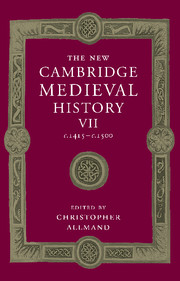Book contents
- Frontmatter
- PART I GOVERNMENT
- PART II ECONOMIC AND SOCIAL DEVELOPMENTS
- PART III SPIRITUAL, CULTURAL AND ARTISTIC LIFE
- PART IV THE DEVELOPMENT OF EUROPEAN STATES
- 17 Germany and the Empire
- 18 Hus, the Hussites and Bohemia
- 19 France
- 20 Burgundy
- 21 England
- 22 The Celtic world
- 23 Italy
- 24 The Iberian peninsula
- 25 The Swiss Confederation
- 26 The States of Scandinavia, c. 1390– c. 1536
- 27 Hungary: Crown and Estates
- 28 The Kingdom of Poland and the Grand Duchy of Lithuania, 1370–1506
- 29 Russia
- 30 Byzantium: The Roman Orthodox World, 1393–1492
- 31 The Latin East
- 32 The Ottoman World
- 33 Conclusion
- Appendix Genealogical Tables
- Primary Sources and Secondary Works Arranged by Chapter
- Index
- Frontispiece
- Plate section
- Map 1 European towns in the late Middle Ages
- Map 2 European commerce and trade
- Map 4 Winds and currents facilitating the discoveries
- Map 5 The universities o f Europe in 1400 and 1500
- Map 6 Germany and the Empire
- Map 20 The Roman Orthodox and Ottoman worlds in the fifteenth century
- References
30 - Byzantium: The Roman Orthodox World, 1393–1492
from PART IV - THE DEVELOPMENT OF EUROPEAN STATES
Published online by Cambridge University Press: 28 March 2008
- Frontmatter
- PART I GOVERNMENT
- PART II ECONOMIC AND SOCIAL DEVELOPMENTS
- PART III SPIRITUAL, CULTURAL AND ARTISTIC LIFE
- PART IV THE DEVELOPMENT OF EUROPEAN STATES
- 17 Germany and the Empire
- 18 Hus, the Hussites and Bohemia
- 19 France
- 20 Burgundy
- 21 England
- 22 The Celtic world
- 23 Italy
- 24 The Iberian peninsula
- 25 The Swiss Confederation
- 26 The States of Scandinavia, c. 1390– c. 1536
- 27 Hungary: Crown and Estates
- 28 The Kingdom of Poland and the Grand Duchy of Lithuania, 1370–1506
- 29 Russia
- 30 Byzantium: The Roman Orthodox World, 1393–1492
- 31 The Latin East
- 32 The Ottoman World
- 33 Conclusion
- Appendix Genealogical Tables
- Primary Sources and Secondary Works Arranged by Chapter
- Index
- Frontispiece
- Plate section
- Map 1 European towns in the late Middle Ages
- Map 2 European commerce and trade
- Map 4 Winds and currents facilitating the discoveries
- Map 5 The universities o f Europe in 1400 and 1500
- Map 6 Germany and the Empire
- Map 20 The Roman Orthodox and Ottoman worlds in the fifteenth century
- References
Summary
chronology and definition
byzantines were perhaps more concerned than most medieval people with the insecure business of measuring time and defining authority. There was not much they could do about either, but naming is a taming of the forces of nature and anarchy, and placed the humblest in relation to the stability of God. Byzantines called this order ‘taxis’. They craved taxis all the more in the fifteenth-century Anno Domini, because for Orthodox Christians, who counted by the Anno Mundi, it was, quite simply, the end of the secular world. For subjects of either, or both, emperor and patriarch in Constantinople the New Rome, the world was created on 1 September 5508 bc. Gennadios II Scholarios, Sultan Mehemmed II’s first patriarch after the fall of Constantinople to the Ottoman Turks on 29 May 1453, put matters in cosmic proportion by foretelling doomsday on 1 September 1492, the end of the seventh millennium am. In 1393, the first year of the last century of the world, Patriarch Antonios IV (1389– 97) had put matters in taxis. Grand Prince Vasilii I of Moscow (1389– 1425) had complained that while there was a Church, there did not seem to be a credible emperor in Constantinople, to which the patriarch replied that ‘it is not possible to have a Church without an emperor.
- Type
- Chapter
- Information
- The New Cambridge Medieval History , pp. 771 - 795Publisher: Cambridge University PressPrint publication year: 1998

